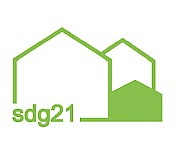The housing shortage is an immense social problem in many large cities and conurbations. At the same time, the building sector has been failing to meet its environmental and climate targets for years. In a recent position paper, the Federal Environment Agency (UBA) and the Commission for Sustainable Building at the UBA (KNBau) have examined how more affordable housing can be created without unnecessarily harming the environment and health. According to this paper, the most important factor for more environmental protection in housing construction is that the existing building stock is preserved wherever possible or is sensibly converted and repurposed. This is the easiest way to avoid climate emissions and unnecessarily high consumption of raw materials. Today, UBA President Prof. Dr. Dirk Messner presented KNBau's proposals to Federal Minister of Building Klara Geywitz and Federal Minister of the Environment Steffi Lemke in Berlin.
Federal Environment Minister Steffi Lemke: "Water scarcity and heat as a result of the climate crisis are putting our cities and their inhabitants under stress. What we need are climate-resilient cities with a cleverly planned blue and green infrastructure of water and urban greenery for nature and human recreation. When it comes to much-needed housing, we can at the same time protect the environment andClimateprotect: In view of the enormous demand for resources in the building sector, we must think housing creation, resource conservation and climate adaptation together. If new housing is created primarily in inner cities and on brownfield sites, and existing buildings are renovated and converted, this saves energy, waste and greenhouse gases and reduces land consumption."
Klara Geywitz, Federal Minister for Housing, Urban Development and Building: "Building andClimate protectionmust always be thought of together and socially. To forego climate standards today when building - whether it is a conversion, an extension or a new building - is already unprofitable in the short term and will harm future generations. We need a new orientation. To achieve this, we must move away from focusing on thePrimary energy consumptiontowards a life cycle assessment of new and existing buildings that takes into account the entire greenhouse gas balance. We are already implementing this with the QNG seal. With the upcoming municipal heat planning as an important component of the heat transition and the upcoming major amendment to the Building Code, which will take up many of the demands from this study, we are planning further necessary steps on the way to the triad 'Building - Climate Protection - Social'."
UBA-President Prof. Dr. Dirk Messner: "In addition to the urgently needed new construction, we must focus more on the conversion and reuse of existing buildings. Otherwise we will miss our climate and resource protection targets in the building sector. The socio-ecological transformation of our cities needs a paradigm shift. New housing in existing buildings saves raw materials and protects the open landscape from further urban sprawl. We also need to recycle and loop much more building materials."
Dr Matthias Lerm, Head of the Magdeburg Urban Planning Office and, together with Prof. Christa Reicher, Head of KNBau: "We also advocate establishing the new guiding principle of triple inner development in urban planning. This means that the urban planning of the future must not play off the three pillars of compact building, healthy urban greenery and sustainable mobility against each other: If today's car park courtyards become house gardens again, this must be accompanied by suitable mobility alternatives, i.e. expanded public transport and sharing services as well as additional bicycle lanes and pedestrian areas. And if, instead of small-scale and loosened up, there is more compact and space-saving building in the future, then intensively usable playgrounds and climate-effective green corridors must also be included in the projects".
In order to reduce climate emissions and the consumption of raw materials in construction, KNBau recommends adapting the model building code and various state building codes. In future, they should be oriented towards ambitious sustainability criteria and, for example, provide for the conservation of resources and the priority of existing buildings over new ones. Promoting framework conditions for the use of particularly ecological building materials should also be anchored there, as well as allowing reduced minimum distances for photovoltaic systems on roofs. In addition, legal foundations in state building codes should be expanded so that standards for precautionary measures against hazards to health and the environment can be prescribed.
Source: UBA PM of 20.02.2023
www.umweltbundesamt.de/...dem-wohnraummangel-oekologisch-begegnen
Keywords:
Stock, DE-News, Renewable, Climate protection, Recycling, Resource efficiency, Environmental policy, Housing, Housing policy

